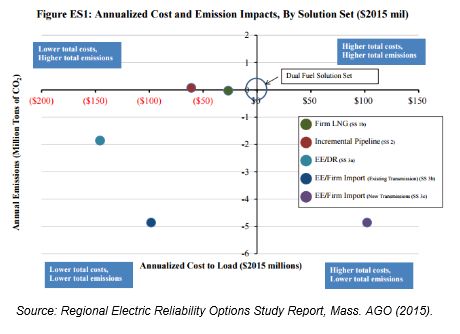Last month the Massachusetts Attorney General's Office released a study concluding that no new gas pipelines are needed for electric reliability in New England, as the region is expected to meet its energy needsthrough 2030.

The study arrives amid a debate regarding the role of gas pipelines in New England's energy future. Recently, the Massachusetts Department of Public Utilities ruled that it had the authority to allow distribution companies to pass along the costs of firm pipeline capacity to ratepayers. That ruling is currently under appeal to the Supreme Judicial Court. (Foley Hoag is counsel to one of the parties appealing.)
The study, completed by Analysis Group, Inc., found that New England will be able to meet electric demand in its coldest months over the next fifteen years, due to both declining long-term peak winter demand as well as an increase in the availability of dual-fuel capable units.
The study also evaluated whether capacity shortfalls could arise in a hypothetical "stressed" scenario, in which it was assumed that New England will become even more reliant on natural gas and will experience short-term disruptions of other fuel sources. The study found that by 2030, under such conditions, the region would experience a 2,400 MW capacity shortfallof no more than twenty-six hours over nine winter days. To address this possibility, a suite of options was evaluated on the basis of cost and potential to meet greenhouse gas (GHG) reduction targets. The options included investing in energy efficiency and demand response (EE/DR), increasing the use of liquefied natural gas (LNG), and both investing in EE and importing low-carbon energy over either new or existing infrastructure.

The study estimated that although gas pipelines could produce $61 million in ratepayer savings per year, they would increase the region's GHG emissions by 80,000 tons per year and impose high up-front costs. According to the study, increasing the supply of LNG using existing infrastructure would impose the lowest up-front cost and would produce $27 million in annual savings and 30,000 tons of GHG reductions. Increased investment in EE/DR was also estimated to produce greater savings to ratepayers and reduce more GHG emissions thanthe gas pipeline solution.
The Attorney General's Office has submitted the study to the Federal Energy Regulatory Commission (FERC) for its consideration in deciding whether to issue a certificate of public convenience and necessity to the Tennessee Pipeline Company, LLC for its proposed gas pipeline between Wright, New York, and Dracut, Massachusetts.
To view Foley Hoag's Energy & Cleantech Counsel blog please click here
The content of this article is intended to provide a general guide to the subject matter. Specialist advice should be sought about your specific circumstances.

